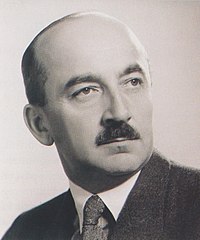Second Hungarian Republic
This article needs additional citations for verification. (November 2012) |
Hungarian Republic Magyar Köztársaság (Hungarian) | |||||||||
|---|---|---|---|---|---|---|---|---|---|
| 1946–1949 | |||||||||
| Anthem: Himnusz (English: "Hymn") | |||||||||
 | |||||||||
| Capital and largest city | Budapest | ||||||||
| Official languages | Hungarian | ||||||||
| Religion | Christianitya (majority) Judaism (minority) | ||||||||
| Demonym(s) | Hungarian | ||||||||
| Government | Unitary Parliamentary Republic
| ||||||||
| President | |||||||||
• 1946–1948 | Zoltán Tildy | ||||||||
• 1948–1949 | Árpád Szakasits | ||||||||
Prime Minister | |||||||||
• 1946–1947 | Ferenc Nagy | ||||||||
• 1947–1948 | Lajos Dinnyés | ||||||||
• 1948–1949 | István Dobi | ||||||||
| Legislature | National Assembly | ||||||||
| Historical era | Cold War | ||||||||
• Monarchy abolished | 1 February 1946 | ||||||||
| 10 February 1947 | |||||||||
| 31 May 1947[1] | |||||||||
| 31 August 1947 | |||||||||
| 20 August 1949 | |||||||||
| Area | |||||||||
| 1946[2] | 93,073 km2 (35,936 sq mi) | ||||||||
| 1947[2] | 93,011 km2 (35,912 sq mi) | ||||||||
| 1949[2] | 93,011 km2 (35,912 sq mi) | ||||||||
| Population | |||||||||
• 1949[3] | 9,204,799 | ||||||||
| Currency | Pengő / Adópengőb Forint | ||||||||
| |||||||||
| Today part of | Hungary Slovakiac | ||||||||
| |||||||||
The Second Hungarian Republic (Hungarian: Második Magyar Köztársaság) was a parliamentary republic briefly established after the disestablishment of the Kingdom of Hungary on 1 February 1946 and was itself dissolved on 20 August 1949. It was succeeded by the Hungarian People's Republic.
The Republic was proclaimed in the aftermath of the Soviet occupation of Hungary at the
By June 1947 the Communist Party had gutted the Smallholders' Party as a political force through the mass arrests and forced exile of its main leaders and had gained effective control of the government, installing a
History
From September 1944 until April 1945, as
The Soviets set up an alternative government in Debrecen on 21 December 1944 before capturing Budapest on 18 January 1945. Zoltán Tildy became the provisional prime minister.

In
During 1945 and 1946, the national currency, the pengő, was all but destroyed by the most ruinous hyperinflation in recorded history. The only way to restore sanity to the economy was a new currency, so the forint was reintroduced in 1946.
By 1947, the power of the other parties in the coalition had been reduced in favour of the Communists, and they became the largest single party in
In October 1947, Rákosi gave the leaders of the non-Communist parties an ultimatum: cooperate with a new, Communist-dominated coalition government or go into exile.
| History of Hungary |
|---|
 |
|
|
The Republic of Hungary effectively ended in June 1948, when the Social Democrats were forced to merge with the Communists to form the
On 18 August 1949, the Parliament passed
See also
References
- ^ "Part 2: Communist take-over, 1946-1949" The Institute for the History of the 1956 Revolution.
- ^ ISBN 963-9556-13-0.
- ^ "Az 1990. évi népszámlálás előzetes adatai". Statisztikai Szemle. 68 (10): 750. October 1990.
- ^ Treaty of Peace with Hungary Archived 2004-12-04 at the Wayback Machine
- ^ Chad Bryant, Chad Carl Bryant, Prague in Black: Nazi Rule and Czech Nationalism, Harvard University Press, 2007, p. 209
- ISBN 9781135274894.
- ^ Hungary: a country study. Library of Congress Federal Research Division, December 1989.



